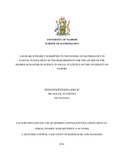| dc.description.abstract | Contraceptive use allows for the deliberate spacing and timing of births. 289,000 women die annually from complications during pregnancy and childbirth, almost all in developing countries. In Kenya, CPR is 58% while that of Kenyan Somali women is at 1.2%. Little is known on the Determinants of modern contraceptives use in Korogocho and Kiamaiko. This study assessed determinants of modern contraceptive practice among, WRA at Korogocho and Kiamaiko. Specific objectives are to determine socio-demographic, identify socio-economic, and determine cultural factors that affect modern contraception. Matched, case-control study design was used. A cohort of 132 women of reproductive age (15-49) were determined using Keish and Leslie (1965) formula. The Subjects were stratified by age into 7 strata‟s and sample was allocated to each stratum by proportional allocation method. Subjects included in the study were picked by simple random sampling. Subjects were distributed to three groups in the (ratio 1:1:1), 22 cases, 22 control group-1, 22 control group-2. The cases and the controls were selected using simple random sampling. Quantitative data were collected by use of questionnaire interviews. SPSS IBM 20, Microsoft Excel and R statistical analysis package were used to analyze the data. Descriptive analysis was used to summarize the data. Conditional logistic regression was fitted to the data with two or more independent variable to conditional logistic regression to establish the relationship between socio-cultural factors, socio-economic factors, contraceptive knowledge and the use of modern contraceptives. McNemar‟s test at 5% level of significance was used to determine factors that significantly contributes to the use/non- use of contraceptives. Understanding the determinants of modern contraceptive was critical to establishing programs that will help to increase modern contraceptive use among Kenyan Somali women in Korogocho and Kiamaiko, consequently, improving the quality of maternal and child health. | en_US |



